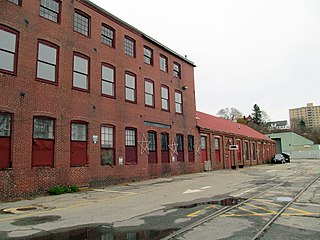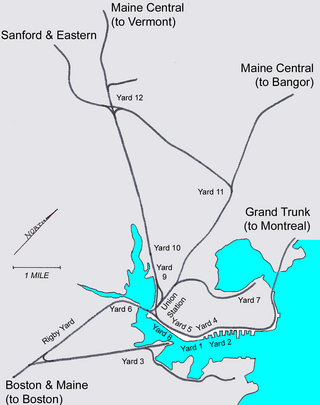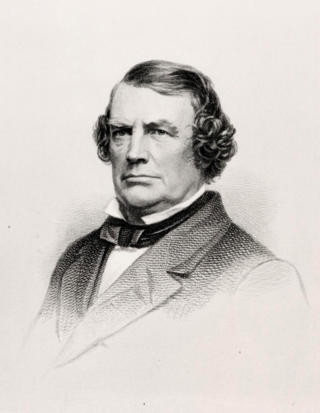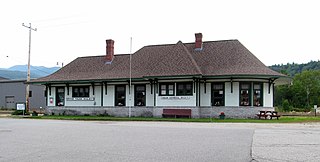
Island Pond is a census-designated place (CDP) in the town of Brighton in Essex County, Vermont, United States. The population was 750 at the 2020 census. It is part of the Berlin, NH–VT Micropolitan Statistical Area.

The Grand Trunk Railway was a railway system that operated in the Canadian provinces of Quebec and Ontario and in the American states of Connecticut, Maine, Michigan, Massachusetts, New Hampshire, and Vermont. The railway was operated from headquarters in Montreal, Quebec, with corporate headquarters in London, United Kingdom. It cost an estimated $160 million to build. The Grand Trunk system and the Canadian Government Railways were precursors of today's Canadian National Railway.

The St. Lawrence and Atlantic Railroad, known as St-Laurent et Atlantique Quebec in Canada, is a short-line railway operating between Portland, Maine, on the Atlantic Ocean, and Montreal, Quebec, on the St. Lawrence River. It crosses the Canada–US border at Norton, Vermont, and Stanhope, Quebec, and is owned by short-line operator Genesee & Wyoming.

The International Railway of Maine was a historic railroad constructed by the Canadian Pacific Railway (CPR) between Lac-Mégantic, Quebec, and Mattawamkeag, Maine, closing a key gap in the railway's transcontinental main line to the port of Saint John, New Brunswick.

The railroad history of Portland, Maine, began in 1842 with the arrival of the Portland, Saco & Portsmouth Railroad (PS&P). Most of the rail activity in Portland concerned agricultural goods bound for export and European import freight. But Maine's largest city also enjoyed 125 years of continuous passenger rail service from 1842 until 1967, and has been served by Amtrak since 2001. For most of Portland's history, passenger train schedules were designed with intercity travel—to Boston, Montreal, Nova Scotia, and points west—rather than daily commuting.

The Portland Company was established 10 November 1846 by John A. Poor and Norris Locomotive Works engineer Septimus Norris as a locomotive foundry to build railroad equipment for the adjacent Portland terminus of the Atlantic and St. Lawrence Railroad connection between Portland, Maine, and Montreal. The shops opened for business in October, 1847. Its first locomotive, the Augusta, emerged from the shops in July 1848 for delivery to the Portland, Saco & Portsmouth. Over the next several decades, the company produced in its Fore Street facilities over 600 steam locomotives as well as 160 merchant and naval vessels, railcars, construction equipment, Knox automobiles, and the like. Portland Company built the engines of the civil war side-wheel gunboats Agawam and Pontoosuc. Taking into account its other products, the company could lay claim to being one of the leading medium-to-heavy steel manufacturers in New England. The company ceased production in 1978.
Grand Trunk railway stations or Grand Trunk railroad stations may refer to former and active passenger rail stations built for the Grand Trunk Railway or its subsidiaries the Grand Trunk Western Railroad and the Grand Trunk Pacific Railway.

The Portland Terminal Company was a terminal railroad notable for its control of switching (shunting) activity for the Maine Central Railroad (MEC) and Boston & Maine (B&M) railroads in the Maine cities of Portland, South Portland, and Westbrook.

The Mountain Division is a railroad line that was once owned and operated by the Maine Central Railroad (MEC). It stretches from Portland, Maine on the Atlantic Ocean, through the Western Maine Mountains and White Mountains of New Hampshire, ending at St. Johnsbury, Vermont in the Northeast Kingdom. The line was abandoned in 1983 by MEC's successor, Guilford Transportation Industries (GTI). Guilford retained a stub between Portland and Westbrook. A section in New Hampshire remains in use by heritage railway Conway Scenic Railroad.

5 ft 6 in (1,676 mm) is a broad track gauge, used in India, Pakistan, western Bangladesh, Sri Lanka, Argentina, Chile, and on BART in the San Francisco Bay Area.

John Alfred Poor was an American lawyer, editor, and entrepreneur best remembered for his association with the Grand Trunk Railway and his role in developing the railroad system in Maine. He was the older brother of Henry Varnum Poor of Standard & Poor's, who was his partner in some business ventures. John Poor was an articulate man standing 6 feet, two inches tall and weighing over 250 pounds (110 kg). He learned the geography and commerce of northern New England during travels as a young man; and developed an early appreciation for the potential of railroads. His commanding presence was enhanced by early speaking experience as a teacher and attorney. He had a unique ability to assemble the necessary resources to build early railroads, although he left the routine work of operations to others.

The Mechanic Falls station was a historic railroad station in Mechanic Falls, Maine. The station, located on Elm Street, was built in 1883 by the Grand Trunk Railroad linking Mechanic Falls with Montreal and Portland, Maine. The village was named Mechanic Falls in honor of mechanics who worked there during the industrial revolution. The village grew especially after the arrival of the St. Lawrence & Atlantic Railroad toward the end of 1840. The railroad opened the village to several business ventures between Portland and Montreal.

Island Pond station is a train station located in Island Pond, Vermont. It was opened in 1853 by the Grand Trunk Railway and closed in 1965. The building has been converted to local use.

Berlin station is a railroad station in Berlin, New Hampshire, United States. It was built in 1917 by the Grand Trunk Railway, long after the arrival of the Railroad in 1845, the reason being that Berlin was not on the railroad's main line further south at Gorham, New Hampshire.

Gorham station is a former Grand Trunk Railway station in Gorham, New Hampshire, United States. It was built in 1907, long after the arrival of the railroad in 1851. The existing station was the third depot. The first was in the White Mountain Station House, which was built by the railroad on what is now the Town Common. When it later became the Alpine House, a small depot was built just east of the hotel. Eventually the Alpine House was moved across Main St. to become the Mt. Madison Inn. Thus a new depot was built in 1907, with a 400' platform.

Coaticook station is a historic building in the small town of Coaticook, Quebec, Canada, close to the border with the United States. The first station, which was on the west side of the tracks, was completed in 1853 by the St. Lawrence and Atlantic Railroad. The current building was constructed on the east side of the tracks in 1904 by the Grand Trunk Railway. The two storey wooden frame building has a single storey conical roofed southerly end and a small extension on the north end. One of the façades includes a two-story bay window topped by a gable-pediment. The old station is located in a semi-wooded area in a residential area of the town.

Richmond station is a historic building located on rue Principale Nord in Richmond in the province of Quebec. The current building was constructed in 1912 by the Grand Trunk Railway (GTR) to replace the previous wood-frame structure which had been destroyed by fire.

Lake Christopher, also known as Bryant Pond, is a two-mile long lake in western Maine. The lake is located in the towns of Woodstock and Greenwood in Oxford County, Maine.
The Maine Coast Special was a summer passenger train operated by the Grand Trunk Railroad between Montreal, Quebec, Portland, Maine and Kennebunk, Maine. It served vacationers to Maine's Atlantic Coast, an important revenue source for the railroad. In addition to a seasonal overnight train, the Grand Trunk ran a daily daytime train that terminated at Portland on India St instead of Kennebunk.

















